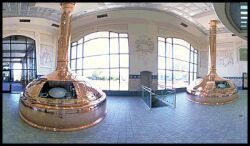A recent essay by author Zadie Smith brought to mind the topic of ‘self’ as we’ve discussed the BBC documentary, The Century of the Self, and the museum’s shifting focus on the complexity and identity of its audience. Smith’s essay, titled “Generation Why?” is largely a critique of The Social Network, a film released earlier this fall about the founding of the online social network, Facebook. Smith’s critique leaps beyond the content of the film to comment on our current society and the increasing importance we place on defining ourselves, as a seemingly increasing portion of this definition comes in the form of the people and things we collect and give preference to in virtual space.
As a class, we have discussed the role of Facebook in our society and our roles as virtual participants, like those discussed by Nina Simon in The Participatory Museum. Simon describes “The network effect,” the underlying concept of social networks, and our various levels of participation, “whether as creators, critics, collectors, joiners or spectators.”
By participating in social networks, in some ways, we are individually creating prescribed-format museums of self. We curate, update, and maintain them. We may create micro-communities with other individuals who share interests and ideas to which we relate, but we increasingly isolate the ‘self’ because we interface with software to a greater extent than the people to whom we are connected in social space.
Connection may be the goal of social networks, but decreased privacy, perhaps an evolved social norm, also affects how the self is virtually portrayed. And one’s expressed likes and dislikes allow for for marketing to be streamlined to his or her self-proclaimed preferences. In this way, we are viewed as individual consumers. Likewise, The Century of the Self reveals the shift from ‘need’ to a ‘desire’ based society.
In her essay, Smith also briefly discusses Jaron Lanier’s book, You Are Not A Gadget. She writes that, “Lanier is interested in the ways in which people, ‘reduce themselves’ in order to make a computer’s description of them appear more accurate.” We are aware that we self-edit for online portrayal and that our number of virtual friends is not an accurate reflection of our actual friends, but it is important to question our awareness of how the software affects us. Software is not neutral, and it is possible to consider that for most of us the lines begin to blur between our reduced, edited selves and our reality.
It is possible to consider that our selves which display our collections of friends and things we like are devoid of the richness of our actual lives and interpersonal connections.
In his publication, Do Museums Still Need Objects, author Stephen Conn wrote about how museums have generally adjusted to changing cultural atmospheres and he concluded that although they may no longer require physical objects to tell their stories, objects endure and offer a rich and unparalleled visual experience all their own.
Likewise, I think that virtual social space cannot offer the same quality of personal connection and reflection found in shared cultural space.
Jayme Elterman



